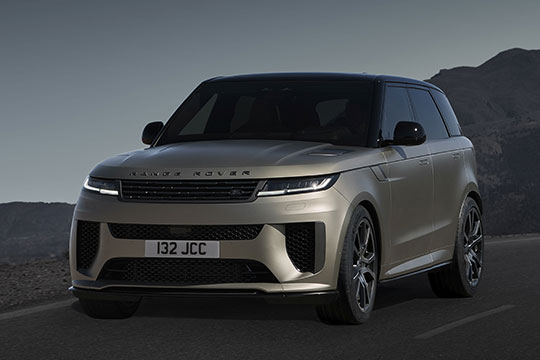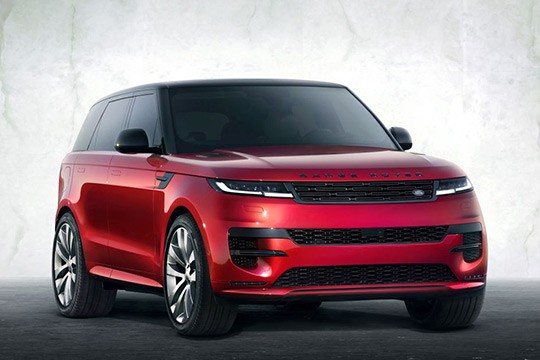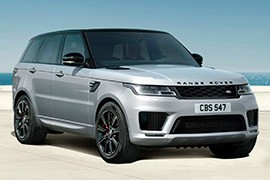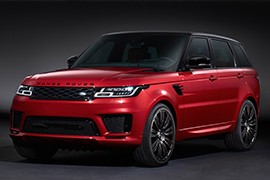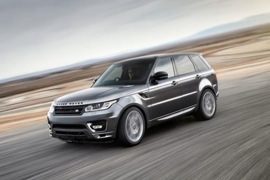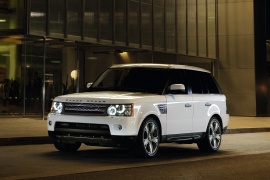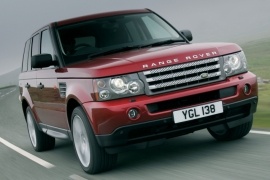LAND ROVER Range Rover Sport Models/Series Timeline, Specifications & Photos
First production year: 2005
Engines: Mild hybrid, Plug-in hybrid, Mild hybrid diesel, Hybrid gasoline, Gasoline, Diesel, Hybrid
Body style: SUV (Sports Utility Vehicle)
Range Rover is known for offering a sportive and luxurious vehicle packed in an SUV body. The new Range Rover Sport SV takes the "sportive" title to new heights as it comes equipped with a 626 hp 4.4-liter Twin-Turbo MHEV V8 petrol engine that propels the car to a staggering max speed of 180 mph (290 kph).
For a more comprehensive approach to its costumers' preferences, Range Rover also offers a hybrid version of the new model where the electric powertrain is coupled with a 3.0-liter six-cylinder petrol engine to provide 542 hp while also offering a fully electric driving range of up to 75 miles (121 km).
This update adapts the car to an urban driving necessity, enabling the driver to make short trips only using electric power quietly and responsively.
Dynamic capabilities are enhanced by the unique 6D Dynamics suspension system, an innovative technology that combines hydraulic interlinked dampers, adjustable air springs, and pitch control to increase grip and stability in high-speed corners and sudden accelerations.
To complement the balancing capabilities, the Range Rover Sport SV is the first production car to offer 23-inch carbon fiber wheels with a total weight reduction of over 77 lbs (35 kg), compared to the standard 23-inch cast-alloy wheels.
A vehicle with this size and power needs a significant force to stop, and Range Rover ensures that the braking capabilities match the speed achievements of the car with the addition of Carbon Ceramic Brakes for the first time on a vehicle constructed by them.
The reduction of unsprung mass is just a little addition to the fact that the ceramic brakes offer a way better performance at high temperatures. Over and above this, the wheels are equipped with the largest front calipers ever installed on a Range Rover. The unique eight-piston Brembo Octyma calipers are specifically developed for this vehicle.
To fully utilize the enhanced dynamic capabilities of the new Range Rover Sport SV, drivers can elevate the car's sporty character by simply pressing the newly introduced SV Mode button located on the steering wheel.
Going beyond the existing Dynamic mode of the Range Rover Sport, SV Mode fine-tunes various aspects of the vehicle. This includes optimizing the steering, eight-speed automatic gearbox, throttle response, exhaust sound, and the 6D Dynamics suspension system. Combining these adjustments results in an exhilarating and immersive driving experience, maximizing the car's dynamic potential.
Elevating the feeling of connection to a new level, the new Range Rover Sport SV introduces the Body and Soul Seat (BASS), an immersive audio experience that brings wellness benefits by allowing front seat occupants to sense the sound physically through synchronized audio vibrations. Setting a new precedent, this is the first production vehicle to integrate a tactile audio system developed by SUBPAC.
LAND ROVER Range Rover Sport SV 4.4L V8 MHEV 8AT AWD (635 HP)
Land Rover introduced a new generation of the Range Rover Sport model in 2022 and stepped up its game by introducing high-tech elements into the car.
When Land Rover introduced the Range Rover Sport lineup in 2005, it built it on top of the Land Rover Discovery 3 platform, but with luxury amenities carried over from the Range Rover flagship model, while the second generation of the RRS was built on top of the L405 platform shared with both Range Rover and Land Rover Discovery 4. For the 2022 model, the carmaker chose the new MLA (Modulable Longitudinal Architecture) previously used only on the Jaguar XJ, J-Pace, and Range Rover.
The new design carried over some elements seen on the Range Rover Velar lineup, with the retractable door handles and the sharp lines on the new LED headlights. Its raked windshield was already characteristic on the RRS ever since the first generation, and so was the raked-forward rear windscreen. To conceal the tall front end, the carmaker used a fat bumper fitted with a lower and an upper grille, flanked on the sides by the foglights' clusters. Thus, the main grille appeared more like a horizontal, patterned slat connecting the headlamps.
Land Rover created a minimalist design inside the cabin, sporting a 13.7" TFT display in front of the driver and a 13.1" curved touchscreen placed instead of the regular center stack. That was continued by a tall center console that divided the front bucket seats. The carmaker knew that these vehicles were mostly used by up to four people, so the rear middle seat was more of a narrow passing place between the two comfortable outer seats. Still, it offered a third headrest at the back.
Under the hood, the carmaker installed mild-hybrid drivetrains either fed by gasoline or turbo-diesel engines. The top-of-the-range version featured a twin-turbocharged V8 unit carried over from BMW.
Land Rover decided to introduce a brand new member of the Ingenium engine family by first fitting it under the hood of a special edition Range Rover Sport, which is oddly named the HST. The car itself is quasi-identical to a regular Range Rover Sport, save for some special badging and carbon fiber trim on the hood, front grille, side air vents and the tailgate.
The real new is found under that flat hood, where a turbocharged 3.0-liter straight-six powerplant has been paired with an integrated starter/motor that takes its juice from a small 48-volt lithium-ion battery.
Essentially a mild-hybrid in the vein of Mercedes-Benz's similar straight-sixes, the new Jaguar Land Rover engine is part of a GBP 1 billion investment plan into the modular Ingenium powerplants. The electric energy harvested by the 48-volt system through regenerative braking is used to either assist the internal combustion engine or power an electric supercharger.
With no less than 400 horsepower and 550 Nm of torque from a 3.0-liter displacement, the Range Rover Sport HST's engine is more responsive and inherently better balanced than the V6 it replaces. On top of it, the addition of the electric supercharger alongside a twin-scroll turbocharger virtually eliminates turbo lag. After the HST it will be available on other JLR products as well.
The first generation of the Land Rover Range Rover Sport was launched in 2005 and it was changed in 2013 when the second generation was released. In 2017 a facelift was introduced.
The 2018 Range Rover Sport received many upgrades on all the important areas: exterior, interior, and drivetrain. But the car was true to its core-roots, as a vehicle suit for hard off-roading and still be able to be driven in crowded cities and look good in front of the Opera.
The new LED headlights were fitted as standard, but offered in four levels: LED, Matrix, Pixel, and Pixel-laser LED. While the first version offered a good illumination for the road with 24 LEDs, the top version offered 144 light-emitting diodes that could light-up the road up to 500 meters. In the newly designed bumper, the LED fog-lights were slimmer and brighter. In the back, a bigger spoiler was installed to prevent the dirt on the rear windscreen.
Inside, the Range Rover Sport received an ample revamp with the introduction of the dual-view touch-screen monitor from the Range Rover Velar. The new, slimmer, front seats offered better body support. The standard version offered 8-way adjustments and a top version with up to 16-ways. To enhance the quality of the inside air, the Range Rover Sport was fitted with an air ionization system.
While the plug-in hybrid and the SVR were special versions for the Range Rover Sport the other versions were fitted with a choice of three engines with gasoline or diesel. The standard transmission was an 8-speed automatic. All versions were fitted with all-wheel-drive traction system and a low-range for hard, off-road, driving situations.
Land Rover introduced the second generation of the Range Rover Sport in March 2013 at the New York Auto Show, and it was the first generation of this nameplate made after the departure from Ford Motor Company.
Right before the world financial crisis, Ford sold Jaguar-Land Rover to the Indian industrial giant Tata. The new management continued some of the products, and the Range Rover Sport was one of them. It was the only Land Rover that could successfully compete against other sporty-looking SUVs from the market. Moreover, unlike its main competitors, it could tackle serious off-road trials thanks to its unique Terrain-response feature with low-range gearing and adaptive suspension. In addition, the luxurious cabin was enhanced, and new technologies found their way to help drivers have a pleasant drive.
Land Rover used the same recipe as on the previous generation of the Range Rover Sport and built the second iteration of this nameplate on top of the same platform as the Land Rover Discovery. For the exterior, on the other hand, designers took inspiration from the successful Range Rover Evoque, with narrow headlights swept back on the front fenders. Depending on the trim level, the front grille was either piano black or sported the body’s color. The British automaker used a sportier design approach for the front bumper, with a trapezoidal-shaped broad lower grille flanked by side scoops that housed the fog lamps. From its profile, the 2013 Range Rover Sport featured a fake vent behind the upper side of the front fenders. Land Rover enlarged the front and rear wheel wells to further emphasize the car's sporty character. At the back, the raked-forward tailgate was already a hallmark of the vehicle, and the automaker continued to use it but adorned it with a roof spoiler. Under the rear bumper, depending on the engine version, the RRS featured one or two exhausts peeking through the apron.
The interior was luxurious and provided better seats than on its predecessor. Its bolstered seats at the front provided more comfort and better side support for high-speed cornering, even if the SUV was not exactly a sports car. Between the front seats, Land Rover installed a tilted center stack where it placed the 8” touchscreen for the infotainment system and the dials for the HVAC unit. It was continued on the lower side by the center console that housed the gear selector, a pair of cup holders, and the rotary knob for the Terrain Response driving program unit. Fronting the driver was a new 12.3” screen for the instrument cluster offered as an option, while the standard version featured two analog dials that flanked a 5” color display. In the back, the automaker installed a split folding seat bench fit for three adults. Furthermore, the automaker offered the option for a flat-folding set of two seats in the trunk area, which was suitable mostly for children or adults on short jaunts.
Under the hood, Land Rover used the same gasoline engines as Jaguar, starting with a 3.0-liter supercharged V6, while the top-of-the-range version was powered by a 5.0-liter V8 supercharged powerplant. For selected markets, the British automaker offered a few turbo-diesel versions. But the most significant updates were for the chassis, which got greater suspension travel and higher ground clearance than its predecessor.
Land Rover was already working on the facelifted Range Rover Sport model when Ford sold it to Tata Industries, but it continued its work and introduced the updated version in 2009.
It was the first product launched by Land Rover after Ford sold them. Even though in 2009 the world financial crisis was not over yet in Europe, the carmaker had high-hopes for the refreshed version, which offered a great deal of comfort and an enhanced look. Moreover, its new powerplants were greatly improved.
The new version featured a new front fascia with circular LED for the daytime driving lights. A horizontal slat crossed its silver mesh-grille. The carmaker added two fog lights in the plastic wrapped-around bumper and a shield at the lower side, and a new set of taillights with a clear lens over the re-arranged lamps inside at the back. Like its predecessor, the car was based on the same platform as the Land Rover Discovery but with a sportier and luxurious look.
Despite its massive appearance, the interior was not that spacious, and the elbow and hip room were limited for three passengers in the back. It was comfortable for four adults. Between the front seats, the carmaker added a standard tall center console with a large storage compartment. Depending on the trim level, it offered either a simple CD stereo or an infotainment unit with a navigation system.
Under the hood, an important addition was the new 3.0-liter turbo-diesel engine, which provided almost the same performances as the 3.6-liter V-8 oil-burner. For the gasoline units, the carmaker introduced the upgraded 5.0-liter V-8 with or without a supercharger.
The Land Rover Range Rover Sport was an interesting surprise in 2006 when it was launched. The market was in full expansion and the demand for SUVs was into a constant crescendo. Then owned by Ford, the Land Rover brand launched a sportier version of its well-known Range Rover.
The Range Rover Sport had the same chassis as the Discovery, but the body was very different. A sloped back and shorter greenhouse were the main characteristics that made it look special. Inside, the luxurious interior was closer to the flagship Range Rover than to the materials found in the Discovery range.
For the engine compartment, Land Rover installed two V8 units. The base model was 4.4-liter gasoline with 300 hp while the top version had Jaguar's supercharged 4.2 liter V8 with 390 hp. Both versions were mated to a 6-speed automatic transmission. All-wheel-drive was standard and, for off-road capabilities, a central locking differential and a two-speed transfer case were installed. Performance both on and off-road was very good. The 0-100kph (0-62 mph) sprint was obtained in 7.2 seconds for the supercharged version while the top speed was 209 kph (130 mph) for both engine variants.
The Range Rover Sport was equipped with air suspension for a more comfortable ride on roads and was able to increase the model's ground clearance for off-roading.
